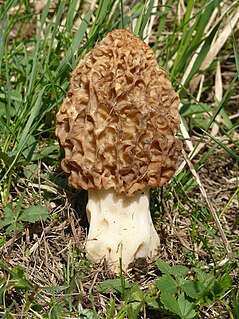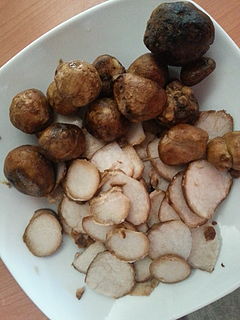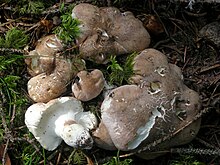
A truffle is the fruiting body of a subterranean ascomycete fungus, predominantly one of the many species of the genus Tuber. In addition to Tuber, many other genera of fungi are classified as truffles including Geopora, Peziza, Choiromyces, Leucangium, and over a hundred others. These genera belong to the class Pezizomycetes and the Pezizales order. Several truffle-like basidiomycetes are excluded from Pezizales, including Rhizopogon and Glomus. Truffles are ectomycorrhizal fungi, so are usually found in close association with tree roots. Spore dispersal is accomplished through fungivores, animals that eat fungi. These fungi have significant ecological roles in nutrient cycling and drought tolerance.

The Boletaceae are a family of mushroom-forming fungi, primarily characterised by small pores on the spore-bearing hymenial surface, instead of gills as are found in most agarics. Nearly as widely distributed as the agarics, the family is renowned for hosting some prime edible species highly sought after by mushroom hunters worldwide, such as the cep or king bolete . A number of rare or threatened species are also present in the family, that have become the focus of increasing conservation concerns. As a whole, the typical members of the family are commonly known as boletes.

Gyromitra is a genus of about 18 species of ascomycete fungi.

The Cortinariaceae are a large family of gilled mushrooms found worldwide, containing over 2100 species. The family takes its name from its largest genus, the varied species of the genus Cortinarius. Many genera formerly in the Cortinariaceae have been placed in various other families, including Hymenogastraceae, Inocybaceae and Bolbitiaceae.

The Hymenogastraceae are a family of fungi in the order Agaricales with both agaric and false-truffle shaped fruitbodies. Formerly, prior to molecular analyses, the family was restricted to the false-truffle genera. The mushroom genus Psilocybe in the Hymenogastraceae is now restricted to the hallucinogenic species while nonhallucinogenic former species are largely in the genus Deconica classified in the Strophariaceae.

Verpa is a genus of ascomycete fungi related to the morels. Resembling the latter genus in edibility and form, the common name early morels is popular. There are five species in the widespread genus.

The Discinaceae are a family of ascomycete fungi, the best known members of which are the false morels of the genus Gyromitra. Originally erected by Erich Heinz Benedix in 1961, it was found to be a discrete clade in a molecular study of ribosomal DNA by mycologist Kerry O'Donnell in 1997. As of 2008, the family is thought to contain 5 genera and 58 species.

The Morchellaceae are a family of ascomycete fungi in the order Pezizales. According to a standard reference work, the family has contained at least 49 species distributed among 4 genera, but in 2012, 5 genera producing the sequestrate and hypogeous ascoma were added. The best-known members are the highly regarded and commercially picked true morels of the genus Morchella, the thimble morels of the genus Verpa, and a genus of cup-shaped fungi Disciotis. The remaining four genera produce the sequestrate fruit bodies.

The Helvellaceae are a family of ascomycete fungi, the best-known members of which are the elfin saddles of the genus Helvella. Originally erected by Elias Magnus Fries in 1823 as Elvellacei, it contained many genera. Several of these, such as Gyromitra and Discina, have been found to be more distantly related in a molecular study of ribosomal DNA by mycologist Kerry O'Donnell in 1997, leaving a much smaller core clade now redefined as Helvellaceae. Instead, this narrowly defined group is most closely related to the true truffles of the Tuberaceae. Although the Dictionary of the Fungi considered the Helvellaceae to contain six genera and 63 species, genetic analysis has shown that Leucangium, previously classified in this family, is more closely related to the Morchellaceae.

Rhizopogonaceae are a family of fungi in the order Boletales. The family, first named and described by botanists Ernst Albert Gäumann and Carroll William Dodge in 1928, contains 2 genera and 151 species. The genus Fevansia, formerly thought to belong in the Rhizopogonaceae, was found to belong in the Albatrellaceae in a molecular phylogenetics study.

Kalaharituber is a fungal genus in the family Pezizaceae. It is a monotypic genus, whose single truffle-like species, K. pfeilii, is found in the Kalahari Desert, which spans the larger part of Botswana, the east of Namibia and the Northern Cape Province of South Africa.
Fevansia is a fungal genus in the family Albatrellaceae. A monotypic genus, it contains the single rare truffle-like species Fevansia aurantiaca, found in old-growth forests of Oregon. The name Fevansia honors Frank Evans of the North American Truffling Society, who collected the holotype specimen. Aurantiaca is Latin for "pale orange", referring to the color of the peridium.

Leucangium is a genus of ascomycete fungi. The genus was circumscribed by French mycologist Lucien Quélet in 1883. Although classified in the Helvellaceae in the past, molecular analysis indicates it is closely related to the genus Fischerula and Imaia, and therefore must be placed in the Morchellaceae. The genus includes two species, Leucangium ophthalmosporum Quél. and L. carthusianum Paol., and both of them produce sequestrate ascoma, globose to ellipsoidal ascus, and dark olive-colored to grayish green, smooth, fusiform ascospores.

Tuber is a genus in the Tuberaceae family of fungi, with estimated molecular dating to the end of the Jurassic period. It includes several species of truffles that are highly valued as delicacies.
Dingleya is a genus of truffles in the Tuberaceae family. The genus contains seven species found in Australia. Circumscribed by James Trappe in 1979, the genus is named after New Zealand mycologist Joan Dingley.

Kalapuya brunnea is a species of truffle in the monotypic fungal genus Kalapuya. The truffle occurs only in the Pacific Northwest region of the United States, in western Oregon and northern California. Known locally as the Oregon brown truffle, it was formerly thought to be an undescribed species of Leucangium until molecular analysis demonstrated that it was distinct from that genus. The truffle is reddish brown with a rough and warty outer skin, while the interior spore-producing gleba is initially whitish before developing greyish-brown mottling as it matures. Mature truffles have an odor resembling garlicky cheese, similar to mature Camembert. The species has been harvested for culinary purposes in Oregon.

Byssoporia is a fungal genus in the family Albatrellaceae. The genus is monotypic, containing the single widespread corticioid species Byssoporia terrestris. There are several varieties: sartoryi, lilacinorosea, aurantiaca, sublutea, and parksii. These differ in bruising reaction, presence of clamp connections in the hyphae, or hyphal morphology. It was previously thought to belong in the Atheliaceae, but a molecular phylogenetics found it to belong in the Albatrellaceae.
Leucogaster is a fungal genus in the family Albatrellaceae. The genus, widespread in northern temperate regions, contains about 20 truffle-like species. Some, such as L. rubescens, are edible.

Leucophleps is a genus of truffle-like fungi in the family Albatrellaceae. The genus, widespread in northern temperate regions, contains four species. Leucophleps was circumscribed by American mycologist Harvey Willson Harkness in 1899.
James Martin Trappe is a mycologist and expert in the field of North American truffle species. He has authored or co-authored 450 scientific papers and written three books on the subject. MycoBank lists him as either author or co-author of 401 individual species, and over the course of his career he has helped guide research on mycorrhizal fungi, and reshaped truffle taxonomy: establishing a new order, two new families, and 40 individual genera.
















